Evangelicalism in the United States
In the United States, evangelicalism is a set of spiritual principles practiced by Protestant Christians who believe in the necessity of being born again, emphasize the importance of evangelism, and affirm traditional Protestant teachings on the authority as well as the historicity of the Bible.[1] Comprising nearly a quarter of the US population, evangelicals are diverse group drawn from a variety of denominational backgrounds, including Baptist, Mennonite, Methodist, Holiness, Pentecostal, Reformed and nondenominational churches.[2][3]
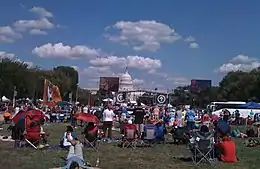
Evangelicalism has played an important role in shaping American religion and culture. The First Great Awakening of the 18th century marked the rise of evangelical religion in colonial America. As the revival spread throughout the Thirteen Colonies, evangelicalism united Americans around a common faith.[1] The Second Great Awakening of the 19th century led to what historian Martin Marty called the "Evangelical Empire", a period in which evangelicals dominated US cultural institutions, including schools and universities. Evangelicals in the northern United States were strong advocates of reform. They were involved in the temperance movement and supported the abolition of slavery in addition to working towards education and criminal justice reform. In the southern United States, evangelicals split from their northern counterparts on the issue of slavery, establishing new denominations that did not call for abolition of slavery.[4] (For example, the Southern Baptist Convention was founded over the issue of slaveholders serving as foreign missionaries.)
By the end of the 19th century, the old evangelical consensus that had united American Protestantism no longer existed. Protestant churches became divided over new intellectual and theological ideas, such as Darwinian evolution and historical criticism of the Bible. Those who embraced these liberal ideas became known as modernists, while those who rejected them became known as fundamentalists. Fundamentalists defended the doctrine of biblical inerrancy and adopted a dispensationalist theological system for interpreting the Bible.[5] As a result of the Fundamentalist–Modernist Controversy of the 1920s and 1930s, fundamentalists lost control of the Mainline Protestant churches and separated themselves from non-fundamentalist churches and cultural institutions.[6]
After World War II, a new generation of conservative Protestants rejected the separatist stance of fundamentalism and began calling themselves evangelicals. Popular evangelist Billy Graham was at the forefront of reviving use of the term. During this time period, a number of evangelical institutions were established, including the National Association of Evangelicals, Christianity Today magazine and a number of educational institutions, such as Fuller Theological Seminary.[7] As a reaction to the 1960s counterculture, many evangelicals became politically active and involved in the Christian right, which became an important voting bloc of the Republican Party. Observers such as Frances FitzGerald have noted that since 2005 the influence of the Christian right among evangelicals has been in decline.[8] Though less visible, some evangelicals identify as Progressive evangelicals.
The annual growth rate of Evangelicalism in the United States is 0.8% according to Operation World,[9] which is higher than the growth rate of the general population (0.59% in 2020).[10] However, the United States ranks 30th in the list of countries where Evangelical growth is least.[9]
Definition

Many scholars have adopted historian David Bebbington's definition of evangelicalism. According to Bebbington, evangelicalism has four major characteristics. These are conversionism (an emphasis on the new birth), biblicism (an emphasis on the Bible as the supreme religious authority), activism (an emphasis on individual engagement in spreading the gospel), and crucicentrism (an emphasis on Christ's sacrifice on the cross as the heart of true religion). This definition, however, has been criticized for being so broad as to include all Christians.[11][12]
Historian Molly Worthen writes that "History—rather than theology or politics—is the most useful tool for pinning down today’s evangelicals."[13] She finds that evangelicals share common origins in the religious revivals and moral crusades of the 18th and 19th centuries. She writes that "Evangelical catchphrases like 'Bible-believing' and 'born again' are modern translations of the Reformers' slogan sola scriptura and Pietists' emphasis on internal spiritual transformation."[13]
Evangelicals are often defined in opposition to Mainline Protestants. According to sociologist Brian Steensland and colleagues, "Evangelical denominations have typically sought more separation from the broader culture, emphasized missionary activity and individual conversion, and taught strict adherence to particular religious doctrines."[14] Mainline Protestants are described as having "an accommodating stance toward modernity, a proactive view on issues of social and economic justice, and pluralism in their tolerance of varied individual beliefs."[15]
Historian George Marsden writes that during the 1950s and 1960s the simplest definition of an evangelical was "anyone who likes Billy Graham". During that period, most people who self-identified with the evangelical movement were affiliated with organizations with some connection to Graham.[16] It can also be defined narrowly as a movement centered around organizations such as the National Association of Evangelicals and Youth for Christ.[12]
The news media often conflates evangelicalism with "conservative Protestantism" or the Christian right. However, not every conservative Protestant identifies as evangelical nor are all evangelicals political conservatives.[17]
Types
Scholars have found it useful to distinguish between the different types of evangelicals. One scheme by sociologist James Davison Hunter identifies four major types: the Baptist tradition, the Holiness and Pentecostal tradition, the Anabaptist tradition, and the Confessional tradition (evangelical Anglicans, pietistic Lutherans and those evangelicals within the Reformed churches).[18][19]
Ethicist Max Stackhouse and historians Donald W. Dayton and Timothy P. Weber divide evangelicalism into three main historical groupings. The first, called "Puritan" or classical evangelicalism, seeks to preserve the doctrinal heritage of the 16th century Protestant Reformation, especially the Reformed tradition. Classical evangelicals emphasize absolute divine sovereignty, forensic justification, and "literalistic" inerrancy. The second, pietistic evangelicalism, originates from the 18th-century pietist movements in Europe and the Great Awakenings in America. Pietistic evangelicals embrace revivalism and a more experiential faith, emphasizing conversion, sanctification, regeneration and healing. The third, fundamentalist evangelicalism, results from the Fundamentalist-Modernist split of the early 20th century. Fundamentalists always emphasize certain "fundamental" beliefs against modernist criticism and sometimes utilize an apocalyptic, premillennialist interpretation of the Bible. These three categories are more fluid than Hunter's, so an individual could identify with only one or all three.[20]
John C. Green, a senior fellow at the Pew Forum on Religion and Public Life, used polling data to separate evangelicals into three broad camps, which he labels as traditionalist, centrist and modernist:[21]
- Traditionalist evangelicals, characterized by high affinity for certain Protestant beliefs, (especially penal substitutionary atonement, justification by faith, the authority of scripture, the priesthood of all believers, etc.) which, when fused with the highly political milieu of Western culture (especially American culture), has resulted in the political disposition that has been labeled the Christian right, with figures like Jerry Falwell and the television evangelist Pat Robertson as its most visible spokesmen.
- Centrist evangelicals, described as socially conservative, mostly avoiding politics, who still support much of traditional Christian theology.
- Modernist evangelicals, a small minority in the movement, have lower levels of church-attendance and "have much more diversity in their beliefs".[21]
History
18th century
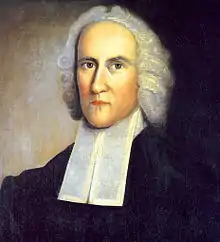
The roots of American evangelicalism lie in the merger of three older Protestant traditions: New England Puritanism, Continental Pietism and Scotch-Irish Presbyterianism.[23] Within their Congregational churches, Puritans promoted experimental or experiential religion, arguing that saving faith required an inward transformation.[24] This led Puritans to demand evidence of a conversion experience (in the form of a conversion narrative) before a convert was admitted to full church membership.[25] In the 1670s and 1680s, Puritan clergy began to promote religious revival in response to a perceived decline in religiosity.[26] The Ulster Scots who immigrated to the American colonies in the 1700s brought with them their own revival tradition, specifically the practice of communion seasons.[27] Pietism was a movement within the Lutheran and Reformed churches in Europe that emphasized a "religion of the heart": the ideal that faith was not simply acceptance of propositional truth but was an emotional "commitment of one's whole being to God" in which one's life became dedicated to self-sacrificial ministry.[28] Pietists promoted the formation of cell groups for Bible study, prayer and accountability.[29]
These three traditions were brought together with the First Great Awakening, a series of revivals occurring in both Britain and its American Colonies during the 1730s and 1740s.[30] The Awakening began within the Congregational churches of New England. In 1734, Jonathan Edwards' preaching on justification by faith instigated a revival in Northampton, Massachusetts. Earlier Puritan revivals had been brief, local affairs, but the Northampton revival was part of a larger wave of revival that affected the Presbyterian and Dutch Reformed churches in the Middle Colonies as well.[31] There the Reformed minister Theodore Frelinghuysen and Presbyterian minister Gilbert Tennent led revivals.[22]
The English evangelist George Whitefield was responsible for spreading the revivals through all the colonies. An Anglican priest, Whitefield had studied at Oxford University prior to ordination and there befriended John Wesley and his brother Charles, the founders of a pietistic movement within the Church of England called Methodism. Whitefield's dramatic preaching style and ability to simplify doctrine made him a popular preacher in England, and in 1739 he arrived in America preaching up and down the Atlantic coastline. Thousands flocked to open-air meetings to hear him preach, and he became a celebrity throughout the colonies.[32]
The Great Awakening hit its peak by 1740,[33] but it shaped a new form of Protestantism that emphasized, according to historian Thomas S. Kidd, "seasons of revival, or outpourings of the Holy Spirit, and on converted sinners experiencing God's love personally" [emphasis in original].[34] Evangelicals believed in the "new birth"—a discernible moment of conversion—and that it was normal for a Christian to have assurance of faith.[35] While the Puritans had also believed in the necessity of conversion, they "had held that assurance is rare, late and the fruit of struggle in the experience of believers".[36]
Its emphasis on the individual's relationship to God gave it an egalitarian streak as well, which was perceived by anti-revivalists as undermining social order. Radical evangelicals ordained uneducated ministers (sometimes nonwhite men) and sometimes allowed nonwhites and women to serve as deacons and elders. They also supported laypeople's right to dissent from their pastors and form new churches.[37]
The Awakening split the Congregational and Presbyterian churches over support for the revival between Old and New Lights (see also the Old Side–New Side Controversy). Ultimately, the evangelical New Lights became the larger faction among both Congregationalists and Presbyterians. The New England theology, based on Jonathan Edwards' work, would become the dominant theological outlook within the Congregational churches.[38][32] In New England, radical New Lights broke away from the established churches and formed Separate Baptist congregations. In the 1740s and 1750s, New Side Presbyterians and Separate Baptists began moving to the Southern colonies and establishing churches. There they challenged the Anglican religious establishment, which was identified with the planter elite. In contrast, evangelicals tended to be neither very rich nor very poor but hardworking farmers and tradesmen who disapproved of the worldliness of the planter class. In the 1760s, the first Methodist missionaries came to America and focused their ministry in the South as well. By 1776, evangelicals outnumbered Anglicans in the South.[39]
During and after the American Revolution, the Anglican Church (now known as the Episcopal Church) experienced much disruption and lost its special legal status and privileges. The four largest denominations were now the Congregationalists, Presbyterians, Baptists and Methodists. In the 1770s and 1780s, the Baptists and Methodists had experienced dramatic growth. In 1770, there were only 150 Baptist and 20 Methodist churches, but in 1790 there were 858 Baptist and 712 Methodist churches. These two evangelical denominations were still most successful in the southern states and along the western frontier. They also appealed to African slaves; on the Delmarva Peninsula, for example, over a third of Methodists were black. In the 1790s, evangelical influence on smaller groups such as Quakers, Lutherans, and the Dutch and German Reformed was still limited. Because of cultural and language barriers, the Dutch and German churches were not a major part of the evangelical revivals.[40]
19th century
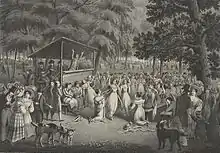
In the 19th century, evangelicalism expanded as a result of the Second Great Awakening (1790s–1840s).[41] The revivals influenced all the major Protestant denominations and turned most Protestants into evangelicals.[42] From the 1790s until the Civil War, evangelicals were the most influential religious leaders in the United States.[11] There were three major centers of revival. In New England, a major revival began among the Congregationalists by the 1820s, led by Edwardsian preachers such as Timothy Dwight, Lyman Beecher, Nathaniel Taylor and Asahel Nettleton. In western New York—the so-called "burned-over district"—the revival was mainly led by Congregationalists and Presbyterians, but there was also some Baptist and Methodist involvement. The third major region of revival was the Cumberland River Valley in Tennessee and Kentucky.[43]
Unlike the East Coast, where revivals tended to be quieter and more solemn, western revivals tended to be more emotional and dramatic.[44] Kentucky was the location of the Revival of 1800 led by Presbyterian minister James McGready. It was here that the traditional Scottish communion season began to evolve into the American camp meeting.[45] A year later, the Cane Ridge Revival led by Barton Stone lasted a week and drew crowds of 20,000 people from the thinly populated frontier. At Cane Ridge, many converts experienced religious ecstasy and "bodily agitations".[46] Some worshipers caught holy laughter, barked like dogs, experienced convulsions, fell into trances, danced, shouted or were slain in the Spirit. Similar things had occurred in other revivals, but they were more intense at Cane Ridge. This revival was the origin of the Stone-Campbell Movement, from which the Churches of Christ and Disciples of Christ denominations originate.[47][46]
During the Second Great Awakening, the Methodist Episcopal Church was the most successful at gaining converts. It enthusiastically adopted camp meetings as a regular part of church life and devoted resources to evangelizing the western frontier. Itinerant ministers known as circuit riders traveled hundreds of miles each year to preach and serve scattered congregations. The Methodists took a democratic and egalitarian approach to ministry, allowing poor and uneducated young men to become circuit riders. The Baptists also expanded rapidly. Like the Methodists, Baptists also sent out itinerant ministers, often with little education.[48]
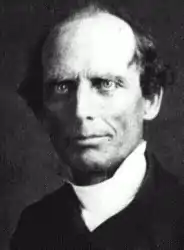
The theology behind the First Great Awakening was largely Calvinist.[49] Calvinists taught predestination and that God only gives salvation to a small group of the elect and condemns everyone else to hell. The Calvinist doctrine of irresistible grace denied to humans free will or any role in their own salvation.[50] The Second Great Awakening was heavily influenced by Arminianism, a theology that allows for free will and gives humans a greater role in their own conversion.[49] The Methodists were Arminians and taught that all people could choose salvation. They also taught that Christians could lose their salvation by backsliding or returning to sin.[50]
The most influential evangelical of the Second Great Awakening was Charles Grandison Finney. Though ordained by the Presbyterian Church, Finney deviated from traditional Calvinism. Finney taught that neither revivals nor conversion occurred without human effort. While divine grace is necessary to persuade people of the truth of Christianity, God does not force salvation upon people. Unlike Edwards, who described revival as a "surprising work of God", Finney taught that "revival is not a miracle" but "the result of the right use of the appropriate means."[51] Finney emphasized several methods to promote revival that have become known as the "new measures" (even though they were not new but had already been in use among the Methodists): mass advertising, protracted revival meetings, allowing women to speak and testify in revival meetings, and the mourner's bench where potential converts sat to pray for conversion.[52]
Evangelical views on eschatology (the doctrine of the end times) have changed over time. The Puritans were premillennialists, which means they believed that Christ would return before the Millennium (a thousand years of godly rule on earth). The First Great Awakening, however, convinced many evangelicals that the millennial kingdom was already being established before Christ returned, a belief known as postmillennialism. During the Second Great Awakening, postmillennialism (with its expectation that society would become progressively more Christianized) became the dominant view since it complemented the Arminian emphasis on self-determination and the Enlightenment's positive view of human potential.[53]
This postmillennial optimism inspired a number of social reform movements among northern evangelicals, including temperance (teetotalism became "a badge of honor" for evangelicals),[54] abolitionism, prison and educational reform.[53] They launched a campaign to end dueling.[55] They built asylums for the physically disabled and mentally ill, schools for the deaf, and hospitals for treating tuberculosis. They formed organizations to provide food, clothing, money, and job placement to immigrants and the poor.[56] In order to "impress the new nation with an indelibly Protestant character", evangelicals founded Sunday schools, colleges and seminaries. They published millions of books, tracts and Christian periodicals through organizations such as the American Tract Society and the American Bible Society.[55] This network of social reform organizations is referred to as the Benevolent Empire. Postmillennialism also led to an increase in missionary work.[53] Many of the major missionary societies were founded around this time (see Timeline of Christian missions).
John Nelson Darby was a 19th-century Irish Anglican minister who devised modern dispensationalism, an innovative Protestant theological interpretation of the Bible that was incorporated in the development of modern evangelicalism. Cyrus Scofield further promoted the influence of dispensationalism through the explanatory notes to his Scofield Reference Bible. According to scholar Mark S. Sweetnam, who takes a cultural studies perspective, dispensationalism can be defined in terms of its Evangelicalism, its insistence on the literal interpretation of Scripture, its recognition of stages in God's dealings with humanity, its expectation of the imminent return of Christ to rapture His saints, and its focus on both apocalypticism and premillennialism.[57]
In the late 19th century, the revivalist Holiness movement, based on the doctrine of "entire sanctification," took a more extreme form in rural America and Canada, where it ultimately broke away from institutional Methodism. In urban Britain the Holiness message was less exclusive and censorious.[58]
In the latter half of the 19th century, Dwight L. Moody of Chicago became a notable evangelical figure. His powerful preaching reached very large audiences.[59][60]
An advanced theological perspective came from the Princeton Theologians from the 1850s to the 1920s, such as Charles Hodge, Archibald Alexander and B.B. Warfield.[61]
20th century
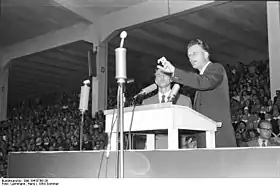
By the 1890s, most American Protestants belonged to evangelical denominations, except for the high church Episcopalians and German Lutherans. In the early 20th century, a divide opened up between the fundamentalists and the mainline Protestant denominations, chiefly over the inerrancy of the Bible. The fundamentalists were those evangelicals who sought to defend their religious traditions, and feared that modern scientific leanings were leading away from the truth. After 1910, evangelicalism was dominated by the fundamentalists, who rejected liberal theology and emphasized the inerrancy of the Scriptures. Evangelicals held the view that the modernist and liberal parties in the Protestant churches had surrendered their heritage as Evangelicals by accommodating the views and values of secularism. At the same time, the modernists criticized fundamentalists for their separatism and their rejection of the Social Gospel. A favored mode of fighting back against liberalism was to prohibit the teaching of Darwinism or macro-evolution as fact in the public schools, a movement that reached its peak in the Scopes Trial of 1925, and resumed in the 1980s. The more modernistic Protestants largely abandoned the term "evangelical" and tolerated evolutionary theories in modern science and even in Biblical studies.
Following the Welsh Methodist revival, the Azusa Street Revival in 1906 began the spread of Pentecostalism in North America.
During and after World War II, evangelicals increasingly organized, and expanded their vision to include the entire world. There was a great expansion of Evangelical activity within the United States, "a revival of revivalism." Youth for Christ was formed; it later became the base for Billy Graham's revivals. At the same time, a split developed between evangelicals, as they disagreed among themselves about how a Christian ought to respond to an unbelieving world. Many evangelicals urged that Christians must engage the culture directly and constructively,[62] and they began to express reservations about being known to the world as fundamentalists. As Kenneth Kantzer put it at the time, the name fundamentalist had become "an embarrassment instead of a badge of honor".[63] The National Association of Evangelicals formed in 1942 as a counterpoise to the mainline Federal Council of Churches. In 1942–43, the Old-Fashioned Revival Hour had a record-setting national radio audience.[64]

The fundamentalists saw the evangelicals as often being too concerned about social acceptance and intellectual respectability, and being too accommodating to a perverse generation that needed correction. In addition, they saw the efforts of evangelist Billy Graham, who worked with non-evangelical denominations, such as the Catholic Church (which they claimed to be heretical), as a mistake. The post-war period also saw growth of the ecumenical movement and the founding of the World Council of Churches, which was generally regarded with suspicion by the evangelical community.
The term neo-evangelicalism was coined by Harold Ockenga in 1947 to identify a distinct movement within self-identified fundamentalist Christianity at the time, especially in the English-speaking world. It described the mood of positivism and non-militancy that characterized that generation. The new generation of evangelicals set as their goal to abandon a militant Bible stance. Instead, they would pursue dialogue, intellectualism, non-judgmentalism, and appeasement. They further called for an increased application of the gospel to the sociological, political, and economic areas. The self-identified fundamentalists also cooperated in separating their "neo-Evangelical" opponents from the fundamentalist name, by increasingly seeking to distinguish themselves from the more open group, whom they often characterized derogatorily by Ockenga's term, "neo-Evangelical" or just evangelical.
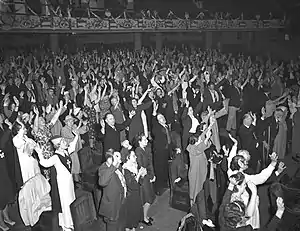
More dramatic than the divisions and newfound organization within Evangelicalism was its expansion of international missionary activity. They had enthusiasm and self-confidence after the national victory in the world war. Many evangelicals came from poor rural districts, but wartime and postwar prosperity dramatically increased the funding resources available for missionary work. While mainline Protestant denominations cut back on their missionary activities, from 7000 to 3000 overseas workers between 1935 and 1980, the evangelicals increased their career foreign missionary force from 12,000 in 1935 to 35,000 in 1980. Meanwhile, Europe was falling behind, as North Americans comprised 41% of all the world's Protestant missionaries in 1936, rising to 52% in 1952 and 72% in 1969. The most active denominations were the Assemblies of God, which nearly tripled from 230 missionaries in 1935 to 626 in 1952, and the United Pentecostal Church International, formed in 1945. The Southern Baptists more than doubled from 405 to 855, as did the Church of the Nazarene from 88 to 200.[65] Overseas missionaries began to prepare for the postwar challenge, most notably the Far Eastern Gospel Crusade (FEGC; now named "Send International"). After Nazi Germany and fascist Japan had been destroyed, the newly mobilized evangelicals were now prepared to combat atheistic communism, secularism, Darwinism, liberalism, Catholicism, and (in overseas missions) paganism.[66]
The Charismatic Movement began in the 1960s and resulted in Pentecostal theology and practice being introduced into many mainline denominations. New Charismatic groups such as the Association of Vineyard Churches and Newfrontiers trace their roots to this period (see also British New Church Movement). The closing years of the 20th century saw controversial postmodern influences entering some parts of evangelicalism, particularly with the emerging church movement.
21st century
A 2018 report of polls conducted from 2003 to 2017 of 174,485 random-sample telephone interviews by ABC News and The Washington Post show significant shifts in U.S. religious identification in those 15 years.[67]
Demographics
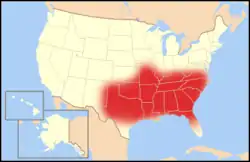
Anywhere from 6 percent to 35 percent of the United States population is evangelical, depending on definition.[68] A 2014 Pew Research Center survey of religious life in the United States identified the evangelical percentage of the population at 25.4 percent while Roman Catholics were 20.8 percent and mainline Protestants were 14.7 percent.[69] A 2008 study showed that in the year 2000 about 9 percent of Americans attended an evangelical service on any given Sunday.[70] The Barna Group reported that 8 percent of Americans in 2006 were born-again evangelicals, defined as those who answered yes to these nine questions:[71][68]
- "Have you made a personal commitment to Jesus Christ that is still important in your life today?"
- "Do you believe that when you die you will go to Heaven because you have confessed your sins and have accepted Jesus Christ as your savior?"
- "Is your faith very important in your life today?"
- "Do you have a personal responsibility to share your religious beliefs about Christ with non-Christians?"
- "Does Satan exist?"
- "Is eternal salvation possible only through grace, not works?"
- "Did Jesus Christ live a sinless life on earth?"
- "Is the Bible accurate in all that it teaches?"
- "Is God the all-knowing, all-powerful, perfect deity who created the universe and still rules it today?"
 An event at Gateway Church's 114 Southlake Campus
An event at Gateway Church's 114 Southlake Campus
Sometimes members of historically black churches are counted as evangelicals, and other times they are not. When analyzing political trends, pollsters often distinguish between white evangelicals (who tend to vote for the Republican Party) and African American Protestants (who share beliefs in common with white evangelicals but tend to vote for the Democratic Party).[68] In 2012, The Economist estimated that "over one-third of Americans, more than 100 M, can be considered evangelical," arguing that the percentage is often undercounted because many African Americans espouse evangelical theology but refer to themselves as "born again Christians" rather than "evangelical."[72] As of 2017, according to The Economist, white evangelicals overall account for about 17 percent of Americans, while white evangelicals under the age of 30 represent about 8 percent of Americans in that age group.[73] Wheaton College's Institute for the Studies of American Evangelicals estimates that about 30 to 35 percent (90 to 100 million people) of the US population is evangelical. These figures include white and black "cultural evangelicals" (Americans who do not regularly attend church but identify as evangelicals).[74] Similarly, a 2019 Gallup survey asking respondents whether they identified as "born-again" or "evangelical" found that 37% of respondents answered in the affirmative.[75]
Politics and social issues
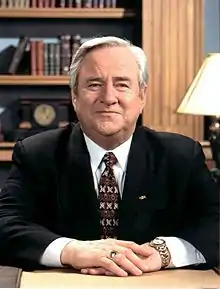
Evangelical political influence in America was first evident in the 1830s with movements such as the prohibition movement, which closed saloons and taverns in state after state until it succeeded nationally in 1919.[77] The Christian right is a coalition of numerous groups of traditionalist and observant church-goers of every kind: especially Catholics on issues such as birth control and abortion, Southern Baptists, Missouri Synod Lutherans, and others.[78] Since the early 1980s, the Christian right has been associated with several nonprofit political and issue-oriented organizations including the Moral Majority, the Christian Coalition, Focus on the Family and the Family Research Council.[79][80] In the 2016 presidential election, 81% of white evangelicals voted for Donald Trump according to exit polls.[81]
Evangelical political activists are not all on the right. There is a small group of liberal white Evangelicals.[82] Most African Americans belong to Baptist, Methodist or other denominations that share evangelical beliefs; they are firmly in the Democratic coalition and (with the possible exception of issues involving abortion and homosexuality) are generally liberal in politics.[83]
Evolution
Evangelicals are often stereotyped as Christians who reject mainstream scientific views out of concern that they contradict the Bible. This is true for some evangelicals, such as those who reject evolution in favor of creation science and flood geology (both of which contradict the scientific consensus).[84] There have been a variety of court cases over whether public schools can teach creationism or intelligent design (the position that the complexity and diversity of life is best explained by the intervention of God or another active intelligence).[85]
However, not all evangelicals believe that evolution is incompatible with Christianity. Prominent evangelicals such as B.B. Warfield, Billy Graham and John Stott believed the theory could be reconciled with Christian teaching.[86] The Biologos Foundation is an evangelical organization that advocates for evolutionary creation.[87] The American Scientific Affiliation is an organization for evangelical professional scientists.[88]
Abortion
Since 1980, a central issue motivating conservative evangelicals' political activism is abortion. The 1973 decision in Roe v. Wade by the Supreme Court, which legalized abortion, proved decisive in bringing together Catholics and evangelicals in a political coalition, which became known as the Religious Right when it successfully mobilized its voters behind presidential candidate Ronald Reagan in 1980.[89]
Church and state
In the United States, Supreme Court decisions that outlawed organized prayer in school and restricted church-related schools (for example, preventing them from engaging in racial discrimination while also receiving a tax exemption) also played a role in mobilizing the Religious Right.[90]
Opponents criticize the Evangelicals, who they say actually want a Christian America—in other words, for America to be a nation in which Christianity is given a privileged position.[91] Survey data shows that "between 64 and 75 percent do not favor a 'Christian Nation' amendment", though between 60 and 75 percent also believe that Christianity and Political Liberalism are incompatible.[92] Evangelical leaders, in turn, counter that they merely seek freedom from the imposition by national elites of an equally subjective secular worldview, and feel that it is their opponents who are violating their rights.[93]
Other issues
According to recent reports in the New York Times, some evangelicals have sought to expand their movement's social agenda to include poverty, combating AIDS in the Third World, and protecting the environment.[94] This is highly contentious within the evangelical community, since more conservative evangelicals believe that this trend is compromising important issues and prioritizing popularity and consensus too highly. Personifying this division were the evangelical leaders James Dobson and Rick Warren, the former who warned of the dangers of a Barack Obama victory in 2008 from his point of view,[95] in contrast with the latter who declined to endorse either major candidate on the grounds that he wanted the church to be less politically divisive and that he agreed substantially with both men.[96]
See also
Notes
References
- FitzGerald 2017, p. 3.
- FitzGerald 2017, p. 2.
- Vickers 2013, p. 27.
- FitzGerald 2017, p. 4-5.
- FitzGerald 2017, p. 5.
- Marsden 1991, pp. 3–4.
- FitzGerald 2017, pp. 5–6.
- FitzGerald 2017, pp. 8–10.
- "Evangelical Growth | Operation World". Operation World. Retrieved June 13, 2020.
- "United States Population (2020) - Worldometer". Worldometers. Retrieved June 13, 2020.
- Noll 2002, p. 5.
- "Defining the Term in Contemporary Context", Defining Evangelicalism, Wheaton College: Institute for the Study of American Evangelicals, archived from the original on June 14, 2016, retrieved June 29, 2016.
- Worthen 2014, p. 4.
- Steensland et al. 2000, p. 249.
- Steensland et al. 2000, p. 248.
- Marsden 1991, p. 6.
- Woodberry & Smith 1998, pp. 25–26.
- Dorrien 1998, p. 2.
- Ellingsen 1991, p. 234.
- Dorrien 1998, pp. 2–3.
- Luo, Michael (April 16, 2006). "Evangelicals Debate the Meaning of 'Evangelical'". The New York Times.
- Sweeney 2005, p. 44.
- Balmer 2002, pp. vii–viii.
- Sweeney 2005, p. 31.
- Youngs 1998, pp. 40–41.
- Kidd 2007, Chapter 1, Amazon Kindle location 148–152.
- Kidd 2007, p. 31.
- Kidd 2007, pp. 24–25.
- Sweeney 2005, p. 34.
- Sweeney 2005, p. 27.
- FitzGerald 2017, p. 14–18.
- FitzGerald 2017, p. 18.
- Sweeney 2005, pp. 44, 48.
- Kidd 2007, p. xiv.
- Kidd 2007, Introduction, Amazon Kindle location 66.
- Bebbington 1993, pp. 43.
- Kidd 2007, Introduction, Amazon Kindle location 79–82.
- Sweeney 2005, p. 59.
- FitzGerald 2017, pp. 22–25.
- Wolffe 2007, pp. 40–41.
- Wolffe 2007, p. 47.
- FitzGerald 2017, p. 25.
- Sweeney 2005, pp. 66–71.
- Wolffe 2007, pp. 62-63.
- Wolffe 2007, p. 58.
- FitzGerald 2017, p. 26.
- Sweeney 2005, p. 72.
- FitzGerald 2017, p. 26–27.
- Sweeney 2005, p. 66.
- FitzGerald 2017, p. 31.
- Sweeney 2005, pp. 67–68.
- Balmer 2002, p. 491.
- Balmer 1999, p. 47–48.
- Sweeney 2005, p. 75.
- Sweeney 2005, p. 74.
- FitzGerald 2017, p. 45.
- Sweetnam, Mark S (2010), "Defining Dispensationalism: A Cultural Studies Perspective", Journal of Religious History, 34 (2): 191–212, doi:10.1111/j.1467-9809.2010.00862.x.
- Bebbington, David W (1996), "The Holiness Movements in British and Canadian Methodism in the Late Nineteenth Century", Proceedings of the Wesley Historical Society, 50 (6): 203–28.
- Bebbington, David W (2005), Dominance of Evangelicalism: The Age of Spurgeon and Moody
- Findlay, James F (1969), Dwight L. Moody: American Evangelist, 1837–1899.
- Hoffecker, W. Andrew (1981), Piety and the Princeton Theologians, Nutley: Presbyterian & Reformed, v.
- Henry, Carl FH (August 29, 2003) [1947], The Uneasy Conscience of Modern Fundamentalism (reprint ed.), Grand Rapids: Eerdmans, ISBN 0-8028-2661-X.
- Zoba, Wendy Murray, The Fundamentalist-Evangelical Split, Belief net, retrieved July 1, 2005.
- Carpenter 1999.
- Carpenter, Joel A (1997), Revive Us Again: The Reawakening of American Fundamentalism, pp. 184–5.
- Miller-Davenport 2013.
- De Jong, Allison (May 10, 2018). "Protestants decline, more have no religion in a sharply shifting religious landscape (POLL) The nation's religious makeup has shifted dramatically in the past 15 years". ABC News. Retrieved December 21, 2020.
- Kurtzleben, Danielle (December 19, 2015). "Are You An Evangelical? Are You Sure?". NPR. Archived from the original on February 28, 2020. Retrieved February 28, 2020.
- "America's Changing Religious Landscape". Pew Research Center. May 12, 2015. Archived from the original on March 30, 2020. Retrieved March 30, 2020.
- Olson, David T (2008), The American Church in Crisis, Grand Rapids: Zondervan, p. 240.
- "Survey Explores Who Qualifies As an Evangelical". barna.com. The Barna Group. Retrieved April 9, 2019.
- "Lift every voice". The Economist. May 5, 2012.
- "The evangelical divide". The Economist. October 12, 2017.
- How Many Evangelicals Are There?, Wheaton College: Institute for the Study of American Evangelicals, archived from the original on January 30, 2016, retrieved June 29, 2016
- "Religion - Gallup Historical Trends". Gallup. 2019. Retrieved November 9, 2020.
- "Political ideology among Evangelical Protestants - Religion in America: U.S. Religious Data, Demographics and Statistics".
- Clark, Norman H (1976), Deliver Us from Evil: An Interpretation of American Prohibition.
- "The Triumph of the Religious Right", The Economist November 11, 2004.
- Himmelstein, Jerome L. (1990), To The Right: The Transformation of American Conservatism, University of California Press.
- Martin, William (1996), With God on Our Side: The Rise of the Religious Right in America, New York: Broadway Books, ISBN 0-7679-2257-3.
- Goldberg, Michelle. "Donald Trump, the Religious Right’s Trojan Horse." New York Times. January 27, 2017. January 27, 2017.
- Shields, Jon A (2009), The Democratic Virtues of the Christian Right, pp. 117, 121.
- Heineman, God is a Conservative, pp 71–2, 173
- Noll 2001, pp. 154, 164.
- Ten Major Court Cases about Evolution and Creationism. National Center for Science Education. 2001. ISBN 978-0-385-52526-8. Retrieved March 21, 2015..
- Kramer, Brad (August 8, 2018). "Famous Christians Who Believed Evolution is Compatible with Christian Faith". biologos.org. Archived from the original on January 6, 2020. Retrieved March 28, 2019.
- Sullivan, Amy (May 2, 2009). "Helping Christians Reconcile God with Science". Time. Archived from the original on September 6, 2019. Retrieved April 10, 2020.
- Noll 2001, p. 163.
- Dudley, Jonathan (2011). Broken Words: The Abuse of Science and Faith in American Politics. Crown Publishing Group. ISBN 978-0-385-52526-8. Retrieved February 24, 2015..
- Heineman, Kenneth J. (1998). God is a Conservative: Religion, Politics and Morality in Contemporary America. pp. 44–123. ISBN 978-0-8147-3554-1.
- Dershowitz, Alan M (2007), Blasphemy: how the religious right is hijacking our Declaration of Independence, p. 121.
- Smith, Christian (2002). Christian America?: What Evangelicals Really Want. p. 207.
- Limbaugh, David (2003). Persecution: How Liberals are Waging War Against Christians. Regnery. ISBN 0-89526-111-1.
- Kirkpatrick, David D (October 28, 2007). "The Evangelical Crackup". The New York Times Magazine.
- "Edge Boss" (PDF). Akamai. Archived from the original (PDF) on October 31, 2008. Retrieved August 2, 2010.
- Vu, Michelle A (July 29, 2008). "Rick Warren: Pastors Shouldn't Endorse Politicians". The Christian Post. Retrieved October 25, 2011.
Bibliography
- Balmer, Randall (1999). Blessed Assurance: A History of Evangelicalism in America. Beacon Press. ISBN 0-8070-7710-0.
- ——— (2002). Encyclopedia of Evangelicalism. Louisville, KY: Westminster John Knox Press. ISBN 978-0-664-22409-7..
- Bauder, Kevin (2011), "Fundamentalism", in Naselli, Andrew; Hansen, Collin (eds.), Four Views on the Spectrum of Evangelicalism, Grand Rapids, MI: Zondervan, ISBN 978-0-310-55581-0
- Bebbington, David W (1993), Evangelicalism in Modern Britain: A History from the 1730s to the 1980s, London: Routledge
- Dorrien, Gary J. (1998). The Remaking of Evangelical Theology. Westminster John Knox Press. ISBN 9780664258030.
- Ellingsen, Mark (1991), "Lutheranism", in Dayton, Donald W.; Johnston, Robert K. (eds.), The Variety of American Evangelicalism, Knoxville, TN: The University of Tennessee Press, ISBN 1-57233-158-5
- FitzGerald, Frances (2017). The Evangelicals: The Struggle to Shape America. Simon and Schuster. ISBN 978-1439131336.
- Himmelstein, Jerome L. (1990), To The Right: The Transformation of American Conservatism, University of California Press.
- Kidd, Thomas S. (2007). The Great Awakening: The Roots of Evangelical Christianity in Colonial America (Amazon Kindle). New Haven, Connecticut: Yale University Press. ISBN 978-0-300-11887-2.
- Lantzer, Jason S. (2012). Mainline Christianity: The Past and Future of America's Majority Faith. New York: NYU Press. ISBN 978-0-8147-5330-9.
- Longfield, Bradley J. (2013), Presbyterians and American Culture: A History, Louisville, Kentucky: Westminster John Knox Press
- Lovelace, Richard F (2007), The American Pietism of Cotton Mather: Origins of American Evangelicalism, Wipf & Stock, ISBN 9781556353925
- Marsden, George M. (1991). Understanding Fundamentalism and Evangelicalism. Grand Rapids, MI: W.B. Eerdmans. ISBN 0-8028-0539-6.
- Martin, William (1996), With God on Our Side: The Rise of the Religious Right in America, New York: Broadway Books, ISBN 0-7679-2257-3
- Miller-Davenport, Sarah (2013). "'Their blood shall not be shed in vain': American Evangelical Missionaries and the Search for God and Country in Post–World War II Asia". Journal of American History. 99 (4): 1109–32. doi:10.1093/jahist/jas648. JSTOR 44307506.
- Mohler, Albert (2011), "Confessional Evangelicalism", in Naselli, Andrew; Hansen, Collin (eds.), Four Views on the Spectrum of Evangelicalism, Grand Rapids, MI: Zondervan, ISBN 978-0-310-55581-0
- Noll, Mark A. (2001). American Evangelical Christianity: An Introduction. Blackwell Publishers. ISBN 9780631219996.
- ——— (2002). America's God: From Jonathan Edwards to Abraham Lincoln. Oxford University Press. ISBN 0198034415.
- ——— (2003). The Rise of Evangelicalism: The Age of Edwards, Whitefield and the Wesleys. A History of Evangelicalism. 1. InterVarsity Press. ISBN 1-84474-001-3.
- Olson, Roger (2011), "Postconservative Evangelicalism", in Naselli, Andrew; Hansen, Collin (eds.), Four Views on the Spectrum of Evangelicalism, Grand Rapids, MI: Zondervan, ISBN 978-0-310-55581-0
- Reimer, Sam (2003). Evangelicals and the Continental Divide: The Conservative Protestant Subculture in Canada and the United States. McGill-Queen's Press.
- Shantz, Douglas H (2013), An Introduction to German Pietism: Protestant Renewal at the Dawn of Modern Europe, JHU, ISBN 9781421408309
- Stanley, Brian (2013). The Global Diffusion of Evangelicalism: The Age of Billy Graham and John Stott. IVP Academic. ISBN 978-0-8308-2585-1.
- Steensland, Brian; Park, Jerry Z.; Regnerus, Mark D.; Robinson, Lynn D.; Wilcox, W. Bradford; Woodberry, Robert D. (September 2000). "The Measure of American Religion: Toward Improving the State of the Art". Social Forces. Oxford University Press. 79 (1): 291–318. doi:10.2307/2675572. JSTOR 2675572.
- Sutton, Matthew Avery. American Apocalypse: A History of Modern Evangelicalism (Cambridge: Belknap Press, 2014). 480 pp. online review
- Sweeney, Douglas A. (2005). The American Evangelical Story: A History of the Movement. Baker Academic. ISBN 978-1-58558-382-9.
- Tomlinson, Dave (2007). The Post-Evangelical. ISBN 978-0-310-25385-3.
- Trueman, Carl (2011), The Real Scandal of the Evangelical Mind, Moody Publishers
- Vickers, Jason E. (2013). The Cambridge Companion to American Methodism. Cambridge University Press. ISBN 9781107433922.
- Wolffe, John (2007). The Expansion of Evangelicalism: The Age of Wilberforce, More, Chalmers and Finney. A History of Evangelicalism. 2. InterVarsity Press. ISBN 978-0-8308-2582-0.
- Woodberry, Robert D.; Smith, Christian S. (1998). "Fundamentalism et al: Conservative Protestants in America". Annual Review of Sociology. Annual Reviews. 24: 25–56. doi:10.1146/annurev.soc.24.1.25. JSTOR 223473.
- Worthen, Molly (2014). Apostles of Reason: The Crisis of Authority in American Evangelicalism. Oxford University Press. ISBN 978-0-19-989646-2.
- Youngs, J. William T. (1998). The Congregationalists. Denominations in America. 4 (Student ed.). Westport, Connecticut: Praeger. ISBN 9780275964412.
Further reading
- American Evangelicalism and Islam: From the Antichrist to the Mahdi, Germany: Qantara.
- Balmer, Randall Herbert (2010), The Making of Evangelicalism: From Revivalism to Politics and Beyond, ISBN 978-1-60258-243-9.
- Beale, David O (1986), In Pursuit of Purity: American Fundamentalism Since 1850, Greenville, SC: Bob Jones University: Unusual, ISBN 0-89084-350-3.
- Carpenter, Joel A. (1980), "Fundamentalist Institutions and the Rise of Evangelical Protestantism, 1929–1942", Church History, 49 (1): 62–75, doi:10.2307/3164640, JSTOR 3164640.
- ——— (1999), Revive Us Again: The Reawakening of American Fundamentalism, Oxford University Press, ISBN 0-19-512907-5.
- Carter, Heath W. and Laura Rominger Porter, eds. Turning Points in the History of American Evangelicalism (Eerdmans, 2017). xviii, 297 pp
- Chapman, Mark B., "American Evangelical Attitudes Toward Catholicism: Post-World War II to Vatican II," U.S. Catholic Historian, 33#1 (Winter 2015), 25–54.
- Compton, John W. 2020. The End of Empathy: Why White Protestants Stopped Loving Their Neighbors. Oxford University Press.
- Grainger, Brett. Church in the Wild: Evangelicals in Antebellum America (Harvard UP, 2019) online review
- Griffith, R. M. (2017). Moral combat: how sex divided American Christians and fractured American politics. New York: Basic Books, ISBN 9780465094769. History of sexual politics in the United States, 1920–2017, and how it has influenced the formation of political identities in American Christian denominations.
- Knox, Ronald (1950), Enthusiasm: a Chapter in the History of Religion, with Special Reference to the XVII and XVIII Centuries, Oxford, Eng: Oxford University Press, pp. viii, 622 pp.
- Luhrmann, Tanya (2012) When God Talks Back-Understanding the American Evangelical Relationship with God, Knopf
- Marsden, George M (1987), Reforming Fundamentalism: Fuller Seminary and the New Evangelicalism, Grand Rapids: William B. Eerdmans.
- Menikoff, Aaron (2014). Politics and Piety: Baptist Social Reform in America, 1770–1860. Wipf and Stock Publishers. ISBN 9781630872823.
- Naselli, A. D., and Collin Hansen, eds (2011), Four Views on the Spectrum of Evangelicalism, Grand Rapids, MI: Zondervan. ISBN 9780310293163.
- Noll, Mark A (1992), A History of Christianity in the United States and Canada, Grand Rapids: Wm. B. Eerdmans, pp. 311–89, ISBN 0-8028-0651-1.
- Noll, Mark A; Bebbington, David W; Rawlyk, George A, eds. (1994), Evangelicalism: Comparative Studies of Popular Protestantism in North America, the British Isles and Beyond, 1700–1990.
- Pierard, Richard V. (1979), "The Quest For the Historical Evangelicalism: A Bibliographical Excursus", Fides et Historia, 11 (2): 60–72.
- Price, Robert M. (1986), "Neo-Evangelicals and Scripture: A Forgotten Period of Ferment", Christian Scholars Review, 15 (4): 315–30.
- Rawlyk, George A; Noll, Mark A, eds. (1993), Amazing Grace: Evangelicalism in Australia, Britain, Canada, and the United States.
- Schafer, Axel R (2011), Countercultural Conservatives: American Evangelicalism From the Postwar Revival to the New Christian Right, U. of Wisconsin Press, 225 pp; covers evangelical politics from the 1940s to the 1990s that examines how a diverse, politically pluralistic movement became, largely, the Christian Right.
- Smith, Timothy L (1957), Revivalism and Social Reform: American Protestantism on the Eve of the Civil War
- Spencer, Michael (March 10, 2009), "The Coming Evangelical Collapse", The Christian Science Monitor.
- Sutton, Matthew Avery. American Apocalypse: A history of modern evangelicalism (2014)
- Utzinger, J. Michael (2006), Yet Saints Their Watch Are Keeping: Fundamentalists, Modernists, and the Development of Evangelical Ecclesiology, 1887–1937, Macon: Mercer University Press, ISBN 0-86554-902-8.
- Ward, WR, Early Evangelicalism: A Global Intellectual History, Cambridge: Cambridge University Press.
- Wigger, John H; Hatch, Nathan O, eds. (2001), Methodism and the Shaping of American Culture (essays by scholars).
External links
| Wikiquote has quotations related to: Evangelicalism in the United States |
- "Evangelical Protestant Denominations". Association of Religion Data Archives. 2010. A list of 146 evangelical Protestant denominations in the US.
- Institute for the Study of American Evangelicalism.
- Operation World – Statistics from around the world including numbers of Evangelicals by country.